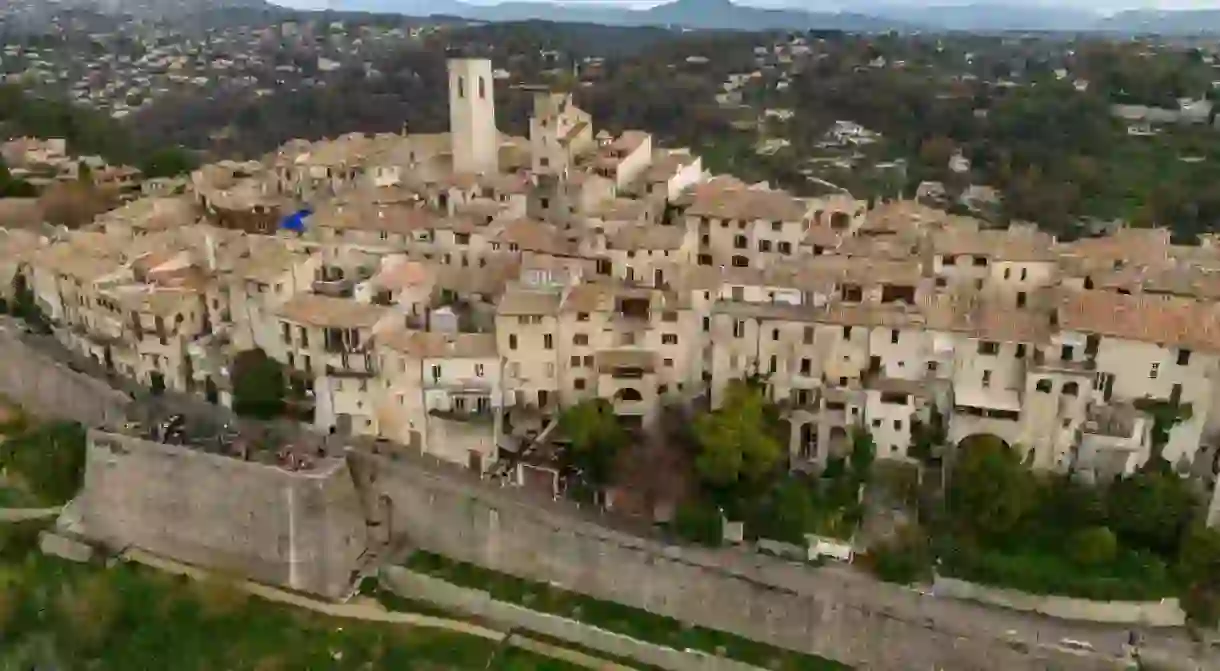10 Best Things to Do In Saint-Paul-de-Vence, France

The hilltop village of Saint-Paul-de-Vence occupies a very enviable corner of Provence and attracts visitors every year for day trips from nearby Nice or to stay within its medieval stone walls. Here are the top 10 things to see and do during your stay in Saint-Paul-de-Vence.
Cimetière de Saint-Paul-de-Vence
Cemetery

There are two main reasons why Saint-Paul-de-Vence’s cemetery is on must-visit lists for explorers to this hilltop village in Provence. Firstly, it is here where you’ll find the grave of painter Marc Chagall. He called Saint-Paul-de-Vence home from 1966 to 1985 and during these years he painted the local landscapes. Secondly, the views from this cemetery are exceptional. Through the Cyprus and palm trees, the Mediterranean twinkles in the distance and from this elevated spot you can appreciate why so many artists were attracted to this area’s colours and light.
La Colombe D’Or
Boutique Hotel Restaurant, European, French

A stylish auberge that was much loved by artists like Picasso and Matisse, dining here is a real experience that’s not to be missed when visiting Saint-Paul-de-Vence. Paul Roux, the founder of this family-run enterprise, had a close relationship with all the artists who treated his boutique hotel like a home away from home. Artists would stay rent-free in exchange for paintings. So even though you feel like you’re dining in a gallery, the art is ingrained in the building’s history and is a must-experience when in Saint-Paul-de-Vence. The food, here is everything you’d expect from the South of France: Mediterranean ingredients with a French flare.
Eglise Collégiale Saint Paul
Church

First built in the 14th century and updated in the 18th century, this beautiful small church still very much exudes a sense of its antiquity. Decorative and calm, it is the perfect place to pause and reflect, especially on a hot Mediterranean day.
Fontaine de Saint-Paul-de-Vence
Ruins

Built in 1615, this central fountain in Saint-Paul-de-Vence is one of the iconic spots of the village. A favourite of the artists who used to frequent the village during the First World War, the fountain is designed in Provencal style with water pouring from four spouts. During the year, the fountain gets adorned with seasonal decorations. The restaurant just behind it – Restaurant La Fontaine – is a great spot to sit and look out over this historic monument and the pretty square.
La Chapelle Folon
Church

The 17th century Folon chapel (restored in the early 2000s) showcases the work of Belgian artist Jean-Michel Folon, who spent much time in Saint-Paul de Vence. Inspired by penitents (a Christian movement where people carried out penance for confession of sins), the church houses an open-hands sculpture, light coloured stained glass windows and simple lines throughout. Entry is €7 per person and free for children up to 12 years old.
Musée Renoir
Museum

Baou de Saint-Jeannet
Natural Feature

Baou de Saint-Jeannet is a mountain located in the Grasse foothills, very popular with hikers and climbers. Find this spot and you’ll be rewarded with the most incredible views back across to Saint-Paul-de-Vence. The closest village to its peak is Saint-Jeannet and under 30 minutes’ drive away, making for the perfect après–midi explore.
The Rosary Chapel
Building, Church

Remparts de Saint-Paul-de-Vence
Building

Dating back to the 16th century and listed as an historic monument in France since 1945, the village’s ramparts are the real highlight. It is from these elevated walls encircling the village that visitors can marvel at the magnificent views and numerous sculptures.
Fondation Maeght
Museum, Art Gallery

The Maeght Foundation is a modern art museum situated in a very beautiful spot on the hilly terrain overlooking the village of Saint-Paul de Vence. It was first created in 1964 by Marguerite and Aimé Maeght and is well-considered for its wealth of sculptures, ceramics, paintings and more. Architect Josep Lluís Sert is behind the building’s attractive lines and the building itself is well worth the visit, especially the external spaces such as the sculpture garden and The Miro Labyrinth, among others. Prices start from €15, while for kids it’s at €10.













